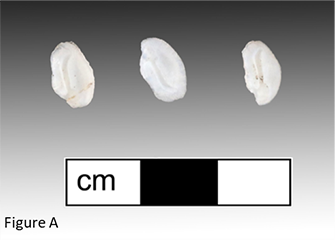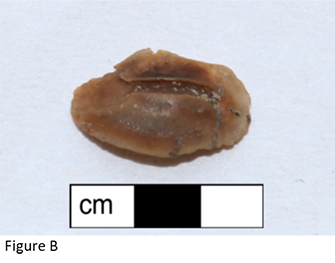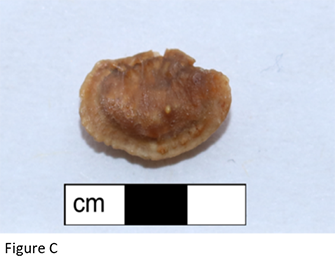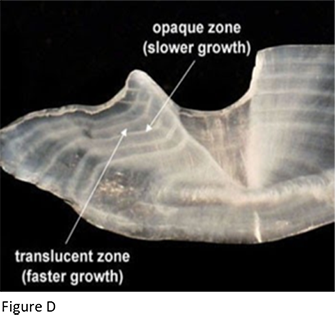Curator's Choice 2020
Overturning Every Stone
November 2020 By Alice Merkel, Collections Assistant
 It is not uncommon for archaeologists to find animal bones at both prehistoric and historic sites. These
It is not uncommon for archaeologists to find animal bones at both prehistoric and historic sites. These
remains can tell us what kind of relationships the inhabitants had with animals--whether they were domesticated or wild or whether they formed a regular part of their diet. Through a close study of the type and the amount of animal remains we find, we can determine how people were hunting, preparing, and cooking animals for food. A major faunal type we find in the Chesapeake region are fish bones. With their small size and delicate features, sometimes it is difficult for archaeologists to find, let alone identify what part of the skeleton a particular bone once belonged to. One of the most curious skeletal remains of a fish is a small, smooth-surfaced bone the size of a pebble called an otolith (Figure A).
Figure A: Otoliths found through dry screening at the Smith St. Leonard Site (18CV91), occupied between 1711 and 1754. The small size of the otoliths often cause them to be missed by archaeologists, calling for careful consideration of every little-pebble look alike.
Otoliths are the ear-stone of the fish; a feature found in all fish other than sharks, rays and lampreys (Casteel 1976:17). Each fish has 3 pairs of otoliths that float inside its soft inner ear canals (Fishing and Wildlife Canada). Each otolith is made up of small build-ups of calcium carbonate crystals. These calcium deposits are derived from both the food the fish eats and the water it lives in during its lifespan. So what is the purpose of these growing ear stones? These deposits seem to be part of the system in charge of controlling the fish’s equilibrium and hearing (Castell 1976:17). There is some suggestion that otoliths may be a functional mechanism of depth perception or serve as a method of measuring sound frequencies.
 By studying otoliths, archaeologists can find out a lot of information about the fish once native to a region. The size of the otolith, for example, can be used to estimate the approximate size of a fish. Even more interestingly, the shape of the otoliths can help archaeologists to determine what species of fish were being caught and eaten by a site’s inhabitants. By looking at the comparatively more sculpted form of the underside of the otolith, it is possible to identify an adult otolith to the generic or species level of fish (Figure B, Casteel 1976:21).
By studying otoliths, archaeologists can find out a lot of information about the fish once native to a region. The size of the otolith, for example, can be used to estimate the approximate size of a fish. Even more interestingly, the shape of the otoliths can help archaeologists to determine what species of fish were being caught and eaten by a site’s inhabitants. By looking at the comparatively more sculpted form of the underside of the otolith, it is possible to identify an adult otolith to the generic or species level of fish (Figure B, Casteel 1976:21).
Figure B and C: Notice the difference in the two faces of the same otoliths. Figure B is of the flatter, more concave face of the otolith that offers little species information. Figure C on the right has a more shapely, convex shape that is distinct to a unique species of fish.
 It is not just the size and shape of otoliths that offer information, as zooarchaeologists can also look at the individual calcium deposits. While calcium deposits can build up at different rates throughout each year of a fish’s life, much like tree rings, by counting the number of deposits zooarchaeologists can estimate the age of a fish (Figure D). Within a laboratory setting, a very thin slice or cross-section can be removed and the rings can be clearly counted. Another method of counting the otolith rings, or annuli, is to crack the otolith in half and then lightly burn it. The burning defines the annuli rings, allowing them to be counted (Fishing and Wildlife Canada).
It is not just the size and shape of otoliths that offer information, as zooarchaeologists can also look at the individual calcium deposits. While calcium deposits can build up at different rates throughout each year of a fish’s life, much like tree rings, by counting the number of deposits zooarchaeologists can estimate the age of a fish (Figure D). Within a laboratory setting, a very thin slice or cross-section can be removed and the rings can be clearly counted. Another method of counting the otolith rings, or annuli, is to crack the otolith in half and then lightly burn it. The burning defines the annuli rings, allowing them to be counted (Fishing and Wildlife Canada).

Figure D: An example of an incredibly thin slice of an otolith, cut in the laboratory using a low-speed diamond bladed saw. The thinness of the otolith cross-section allows scientists to see the difference between the opaque and translucent zones. Each zone indicates different periods of growth in the fish’s lifespan (Florida Fish and Wildlife Conservation Commission).